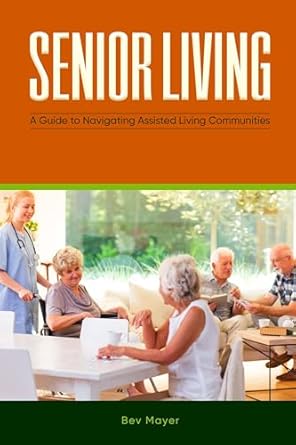
Finding the perfect senior living community is a major decision that can shape your retirement experience, enhance your quality of life, and provide a supportive environment for your golden years. With so many options available, it’s important to look beyond price tags and amenities to determine which community truly meets your physical, social, and emotional needs. This article explores key factors to consider when choosing a senior living community, offers practical strategies for assessing your options, and provides valuable insights to help you make an informed decision. It also highlights one popular Amazon product, The Senior Living Handbook, that can serve as a comprehensive guide during this journey.
Understanding Your Needs and Priorities
Before beginning your search for a senior living community, it’s essential to take a step back and assess your personal needs, lifestyle, and long-term goals. Every individual has unique requirements based on health, social preferences, and financial circumstances. Reflecting on these factors can guide you in finding a community that feels like home.
Evaluating Health and Medical Requirements
Health is often a top priority when choosing a senior living community. Consider the level of care you may need now and in the future. Some communities offer independent living with minimal assistance, while others provide assisted living or skilled nursing care. Evaluate the availability of on-site medical services, emergency response systems, and specialized care programs for chronic conditions such as diabetes, heart disease, or dementia. Ask questions about staffing ratios, staff training, and the community’s approach to healthcare. A community that can adapt to your changing health needs over time is ideal for long-term comfort and security.

Assessing Social and Emotional Well-Being
Retirement is not just about health care, it’s also about community and connection. Consider what type of social environment you desire. Do you prefer a bustling community with a full calendar of events and activities, or are you looking for a quieter, more intimate setting? Look for communities that offer opportunities for social interaction through clubs, group outings, and cultural events. Social engagement is vital for emotional well-being, reducing feelings of isolation and providing a sense of belonging. The right community should foster an environment where you can build friendships, pursue hobbies, and enjoy a supportive network that enhances your overall quality of life.
Financial Considerations and Lifestyle Preferences
Budget is a critical factor when selecting a senior living community. While affordability is important, it shouldn’t be the sole criterion. Consider the value offered in terms of amenities, quality of care, and the overall lifestyle environment. Ask about the fee structure, what services are included, and any additional costs that might arise. It’s also wise to consult with a financial advisor to ensure that your chosen community aligns with your long-term financial goals. Striking a balance between cost and quality can lead to a more satisfying and stress-free retirement.
Key Features of a Quality Senior Living Community
Once you’ve determined your priorities, the next step is to examine the specific features that define a high-quality senior living community. These elements are essential in creating a safe, comfortable, and engaging environment for your retirement.
Safety and Accessibility
Safety should be at the forefront of your decision-making process. Look for communities with secure premises, emergency call systems, and well-maintained facilities. Accessibility is also critical, ensure that the community has features such as grab bars, wheelchair-friendly layouts, and elevators. A safe and accessible environment can prevent accidents and provide peace of mind, allowing you to enjoy your daily activities without worry.
Quality of Care and Staff Engagement
The quality of care provided is a major factor, especially if you anticipate needing assistance in the future. Evaluate the community’s staffing levels, the qualifications of caregivers, and the types of services offered. Ask about the procedures for medical emergencies, the availability of specialized care, and the community’s philosophy on resident independence. A supportive and engaged staff can make a significant difference in your overall satisfaction and quality of life.
Amenities and Lifestyle Programs
A vibrant senior living community offers more than just a place to live, it provides opportunities to thrive. Look for communities that offer a wide range of amenities, including fitness centers, social clubs, cultural events, and educational programs. Amenities should be designed to cater to your interests and help you maintain an active lifestyle. Whether it’s a communal dining area, outdoor spaces for gardening and relaxation, or wellness programs that promote mental and physical health, the right amenities can enhance your overall retirement experience.

Practical Steps for Choosing the Right Community
Selecting the ideal senior living community involves a systematic approach that combines research, personal visits, and thoughtful evaluation. Here are some practical steps to guide you through the process.
Research and Shortlist Potential Communities
Begin by researching various communities in your desired area. Use online resources, reviews, and recommendations from trusted sources to compile a list of potential options. Visit community websites to gather detailed information about the services, amenities, and overall environment. Consider factors such as location, cost, and the level of care provided. Creating a shortlist will help narrow down your choices and focus your efforts on the most promising options.
Visit Communities and Ask Key Questions
Once you have a shortlist, schedule visits to each community. During your visit, observe the overall atmosphere, interact with staff, and speak with current residents if possible. Prepare a list of key questions that address your priorities, questions about safety measures, care services, social activities, and financial details are essential. A personal visit allows you to get a feel for the community’s culture and see firsthand if it meets your needs. Trust your instincts; a warm, welcoming environment can make a significant difference in your day-to-day happiness.
Evaluate Contracts and Financial Arrangements
Before making a final decision, carefully review the contracts and financial arrangements associated with each community. Understand what is included in the base fee and what additional costs may be incurred over time. It is advisable to consult with a financial advisor or legal expert to ensure that you fully understand the terms and that there are no hidden fees. Transparency in financial matters is crucial to avoid future stress and ensure that your investment in a senior living community is both sound and sustainable.
Embracing Technology for a Smoother Transition
Modern technology can significantly simplify the process of choosing and managing a senior living community. Digital tools and online platforms offer a wealth of information that can help you make an informed decision.
Virtual Tours and Online Reviews
Many senior living communities now offer virtual tours on their websites, allowing you to explore the facilities from the comfort of your home. These virtual tours provide a comprehensive view of the living spaces, amenities, and overall environment, giving you a better understanding of what to expect. In addition, reading online reviews from current residents and their families can offer insights into the day-to-day experiences in the community. These digital resources can help you gauge whether a particular community aligns with your expectations and needs.
Utilizing Communication Tools
Staying connected with family, friends, and caregivers is essential during the transition to a new living environment. Technology makes it easier to maintain these connections through video calls, messaging apps, and social media platforms. Tools such as the Amazon Echo Show 8 enable real-time communication with loved ones, ensuring that you never feel isolated during the move or once you settle in. Leveraging these communication tools can provide additional comfort and support, making the transition smoother and more enjoyable.
Amazon Product Spotlight: The Senior Living Handbook
For seniors seeking comprehensive guidance on choosing the right living community, the The Senior Living Handbook is an invaluable resource available on Amazon. This book provides a wealth of practical advice, tips, and insights to help you evaluate different communities and make informed decisions. It covers key topics such as understanding care levels, evaluating amenities, managing financial aspects, and preparing for the emotional transition to a new environment. With real-life testimonials, detailed checklists, and expert advice, the Senior Living Handbook serves as a trusted companion on your journey toward a fulfilling retirement.
Integrating a Holistic Approach to Independent Living
Choosing the right senior living community is not solely about evaluating physical spaces—it’s about embracing a lifestyle that supports overall well-being. A holistic approach to independent living considers physical health, emotional resilience, and social connectivity as interconnected components that contribute to a vibrant, fulfilling life.
Balancing Physical and Mental Health
Maintaining physical health is critical for enjoying a high quality of life in any senior living community. Regular exercise, a balanced diet, and proactive healthcare are foundational elements that support long-term independence. At the same time, mental health and emotional well-being play a crucial role in how you experience your new environment. Engaging in activities that reduce stress, stimulate the mind, and promote social interaction can enhance your overall satisfaction. Look for communities that offer wellness programs, recreational activities, and opportunities for continuous learning to support both your physical and mental health.

Fostering Social Connections and Community Engagement
Social interactions are the cornerstone of a fulfilling retirement. A supportive community not only assists when needed but also offers opportunities for building lasting relationships and creating a sense of belonging. When evaluating senior living options, consider the social atmosphere and the variety of activities available. Whether it’s through communal dining, cultural events, or group outings, engaging with peers can significantly enhance your emotional well-being and enrich your daily life.
Planning for Long-Term Financial and Emotional Security
The decision to move to a senior living community is a long-term investment in your quality of life. It’s important to plan for both financial and emotional security. Carefully review all financial agreements, ask about future fee increases, and consider how the community supports residents as their needs change over time. Emotional security is equally important, choose a community that values independence, fosters a supportive environment, and promotes an active lifestyle. A well-chosen community provides peace of mind and a solid foundation for a vibrant, independent future.
Future Trends in Senior Living Communities
The senior living industry is constantly evolving, with new trends and innovations designed to enhance the quality of life. As technology advances and our understanding of aging deepens, future senior living communities will likely offer even more personalized and integrated care solutions.
Smart Home Integration
Future senior living communities are expected to incorporate smart home technology, offering residents enhanced control over their environment. Automated lighting, climate control, and security systems can make everyday tasks easier and more efficient. These advancements not only improve safety but also contribute to a more comfortable and personalized living experience.
Personalized Care and Wellness Programs
As the demand for personalized care grows, senior living communities are increasingly offering tailored wellness programs that address individual needs. These programs may include customized fitness routines, dietary planning, and mental health support services. By focusing on personalized care, communities can better support residents’ overall well-being and adapt to changing needs over time.
Enhanced Social Connectivity and Community Engagement
Future trends will likely emphasize the importance of social connectivity in senior living. With an increased focus on community engagement, retirement communities may offer more robust social programs, cultural events, and intergenerational activities. These initiatives not only foster a sense of belonging but also encourage lifelong learning and personal growth, ensuring that residents remain active and connected.
Conclusion
Choosing the right senior living community is a multifaceted process that requires careful consideration of your physical, emotional, and financial needs. By evaluating factors such as safety, quality of care, amenities, and social environment, you can find a community that truly feels like home. Embracing a holistic approach to independent living—one that balances physical health, mental well-being, and social connectivity is key to a fulfilling retirement. Leveraging modern technology and reliable resources, such as the The Senior Living Handbook can empower you to make informed decisions and plan for a secure future. As the landscape of senior living continues to evolve with smart home integration and personalized care, the future promises even more opportunities for a vibrant and independent lifestyle. May this guide serve as a valuable resource for seniors, their families, and caregivers, inspiring you to pursue a path that ensures both comfort and growth in your golden years. Embrace the journey, stay informed, and find the community that best supports your unique needs for a truly enriching retirement experience.





